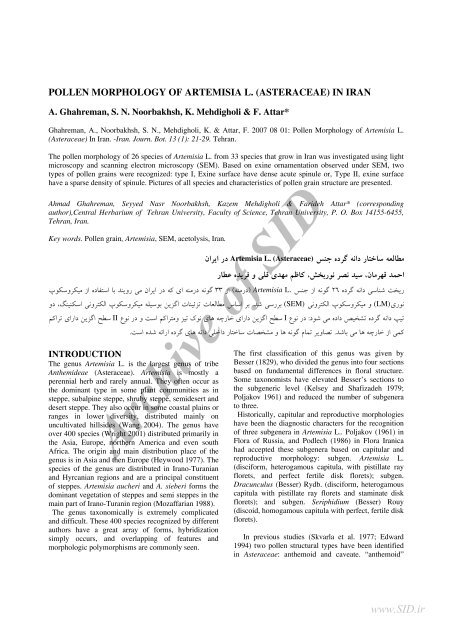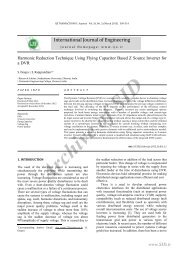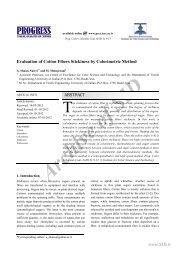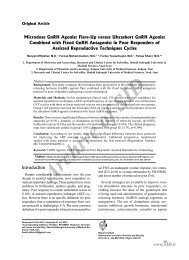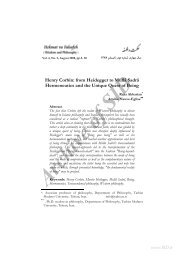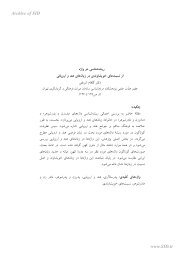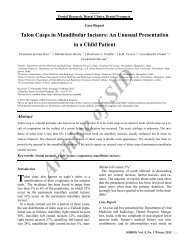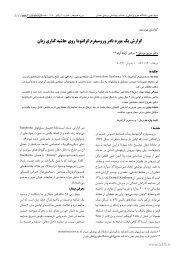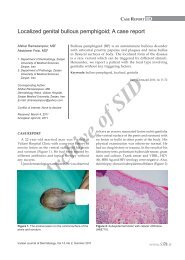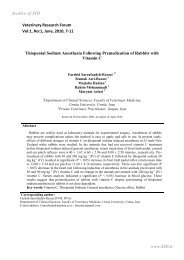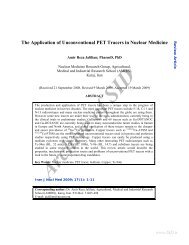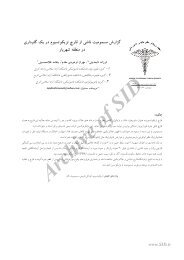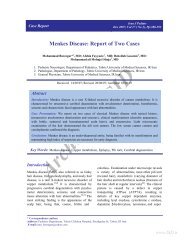POLLEN MORPHOLOGY OF ARTEMISIA L. (ASTERACEAE) IN IRAN
POLLEN MORPHOLOGY OF ARTEMISIA L. (ASTERACEAE) IN IRAN
POLLEN MORPHOLOGY OF ARTEMISIA L. (ASTERACEAE) IN IRAN
Create successful ePaper yourself
Turn your PDF publications into a flip-book with our unique Google optimized e-Paper software.
<strong>POLLEN</strong> <strong>MORPHOLOGY</strong> <strong>OF</strong> <strong>ARTEMISIA</strong> L. (<strong>ASTERACEAE</strong>) <strong>IN</strong> <strong>IRAN</strong><br />
A. Ghahreman, S. N. Noorbakhsh, K. Mehdigholi & F. Attar*<br />
Ghahreman, A., Noorbakhsh, S. N., Mehdigholi, K. & Attar, F. 2007 08 01: Pollen Morphology of Artemisia L.<br />
(Asteraceae) In Iran. -Iran. Journ. Bot. 13 (1): 21-29. Tehran.<br />
The pollen morphology of 26 species of Artemisia L. from 33 species that grow in Iran was investigated using light<br />
microscopy and scanning electron microscopy (SEM). Based on exine ornamentation observed under SEM, two<br />
types of pollen grains were recognized: type I, Exine surface have dense acute spinule or, Type II, exine surface<br />
have a sparse density of spinule. Pictures of all species and characteristics of pollen grain structure are presented.<br />
Ahmad Ghahreman, Seyyed Nasr Noorbakhsh, Kazem Mehdigholi & Farideh Attar* (corresponding<br />
author),Central Herbarium of Tehran University, Faculty of Science, Tehran University, P. O. Box 14155-6455,<br />
Tehran, Iran.<br />
Key words. Pollen grain, Artemisia, SEM, acetolysis, Iran.<br />
ناﺮﻳا رد<br />
Artemisia L. (Asteraceae)<br />
Archive of SID<br />
ﺲﻨﺟ هدﺮﮔ ﻪﻧاد رﺎﺘﺧﺎﺳ ﻪﻌﻟﺎﻄﻣ<br />
رﺎﻄﻋ هﺪﻳﺮﻓ و ﻲﻠﻗ يﺪﻬﻣ ﻢﻇﺎﻛ ،ﺶﺨﺑرﻮﻧ ﺮﺼﻧ ﺪﻴﺳ ،نﺎﻣﺮﻬﻗ ﺪﻤﺣا<br />
پﻮﻜﺳوﺮﻜﻴﻣ زا هدﺎﻔﺘﺳا ﺎﺑ ﺪﻨﻳور ﻲﻣ ناﺮﻳا رد ﻪﻛ يا ﻪﻨﻣرد ﻪﻧﻮﮔ 33 زا ( ﻪﻨﻣرد)<br />
Artemisia L. ﺲﻨﺟ زا ﻪﻧﻮﮔ 26 هدﺮﮔ<br />
ﻪﻧاد ﻲﺳﺎﻨﺷ ﺖﺨﻳر<br />
ود ،ﮓﻨﻴﻨﻜﺳا<br />
ﻲﻧوﺮﺘﻜﻟا پﻮﻜﺳوﺮﻜﻴﻣ ﻪﻠﻴﺳﻮﺑ ﻦﻳﺰﮔا تﺎﻨﻴﺋﺰﺗ تﺎﻌﻟﺎﻄﻣ سﺎﺳا ﺮﺑ . ﺪﺷ ﻲﺳرﺮﺑ (SEM) ﻲﻧوﺮﺘﻜﻟا پﻮﻜﺳوﺮﻜﻴﻣ<br />
و (LM) يرﻮﻧ<br />
ﻢﻛاﺮﺗ ياراد ﻦﻳﺰﮔا ﺢﻄﺳ II عﻮﻧ رد و ﺖﺳا ﻢﻛاﺮﺘﻣو ﺰﻴﺗ كﻮﻧ يﺎﻫ ﻪﭼرﺎﺧ ياراد ﻦﻳﺰﮔا ﺢﻄﺳ I عﻮﻧ رد : دﻮﺷ ﻲﻣ هداد ﺺﻴﺨﺸﺗ هدﺮﮔ ﻪﻧاد ﭗﻴﺗ<br />
. ﺖﺳا هﺪﺷ ﻪﺋارا هدﺮﮔ يﺎﻫ ﻪﻧاد ﻲﻠﺧاد رﺎﺘﺧﺎﺳ تﺎﺼﺨﺸﻣ<br />
و ﺎﻫ ﻪﻧﻮﮔ مﺎﻤﺗ<br />
ﺮﻳوﺎﺼﺗ . ﺪﺷﺎﺑ ﻲﻣ ﺎﻫ ﻪﭼرﺎﺧ زا ﻲﻤﻛ<br />
<strong>IN</strong>TRODUCTION<br />
The genus Artemisia L. is the largest genus of tribe<br />
Anthemideae (Asteraceae). Artemisia is mostly a<br />
perennial herb and rarely annual. They often occur as<br />
the dominant type in some plant communities as in<br />
steppe, subalpine steppe, shruby steppe, semidesert and<br />
desert steppe. They also occur in some coastal plains or<br />
ranges in lower diversity, distributed mainly on<br />
uncultivated hillsides (Wang 2004). The genus have<br />
over 400 species (Wright 2001) distributed primarily in<br />
the Asia, Europe, northern America and even south<br />
Africa. The origin and main distribution place of the<br />
genus is in Asia and then Europe (Heywood 1977). The<br />
species of the genus are distributed in Irano-Turanian<br />
and Hyrcanian regions and are a principal constituent<br />
of steppes. Artemisia aucheri and A. sieberi forms the<br />
dominant vegetation of steppes and semi steppes in the<br />
main part of Irano-Turanin region (Mozaffarian 1988).<br />
The genus taxonomically is extremely complicated<br />
and difficult. These 400 species recognized by different<br />
authors have a great array of forms, hybridization<br />
simply occurs, and overlapping of features and<br />
morphologic polymorphisms are commonly seen.<br />
The first classification of this genus was given by<br />
Besser (1829), who divided the genus into four sections<br />
based on fundamental differences in floral structure.<br />
Some taxonomists have elevated Besser’s sections to<br />
the subgeneric level (Kelsey and Shafizadeh 1979;<br />
Poljakov 1961) and reduced the number of subgenera<br />
to three.<br />
Historically, capitular and reproductive morphologies<br />
have been the diagnostic characters for the recognition<br />
of three subgenera in Artemisia L.. Poljakov (1961) in<br />
Flora of Russia, and Podlech (1986) in Flora Iranica<br />
had accepted these subgenera based on capitular and<br />
reproductive morphology: subgen. Artemisia L.<br />
(disciform, heterogamous capitula, with pistillate ray<br />
florets, and perfect fertile disk florets); subgen.<br />
Dracunculus (Besser) Rydb. (disciform, heterogamous<br />
capitula with pistillate ray florets and staminate disk<br />
florets); and subgen. Seriphidium (Besser) Rouy<br />
(discoid, homogamous capitula with perfect, fertile disk<br />
florets).<br />
In previous studies (Skvarla et al. 1977; Edward<br />
1994) two pollen structural types have been identified<br />
in Asteraceae: anthemoid and caveate. “anthemoid”<br />
www.SID.ir
<strong>IRAN</strong>. JOURN. BOT. 13 (1), 2007 Ghahreman & al. 22<br />
was first applied to pollen grains of Anthemideae<br />
(Skvarla et al. 1977). Anthemoid pollen grains have<br />
basal columellae rising from the foot layer, and one to<br />
several levels of shorter columellae and internal tecta<br />
above the basal columellae. Caveate grains lack basal<br />
columellae, having instead an internal cavity.<br />
Palynological study has also confirmed the existence<br />
of two pollen morphological patterns in the subtribe<br />
Artemisiineae (Anthemideae) which is an important<br />
taxonomic character in the subtribe: Artemisia L. and<br />
its allied and segregate genera, i.e. one with short<br />
spinules (Artemisia L. type) and the other with long<br />
spines (Anthemis Nobilis type). It is thus suggested that<br />
the plants with short spinules evolve from ones with<br />
long spines based on the order of their occurrences in<br />
the geological past (Martín et al. 2001, 2003).<br />
Wodehose (1935) on the basis of the size of the<br />
spine vestiges, had grouped the species of Artemisia<br />
into four different palynological classes as follows: (1)<br />
spine vestiges conspicuous; (2) spine vestiges minute<br />
but still quite large enough to be seen with certainly<br />
under favorable conditions; (3) spine vestiges<br />
represented only by a vanishing trace or even entirely<br />
absent in some grains; (4) spine vestiges generally<br />
entirely absent, though a trace of them may<br />
occasionally be seen on some grains. Generally pollen<br />
grains are prolate to perprolate, 3-zonocolpate type<br />
with smooth inner surface of furrows, in polar view<br />
triangular–trilobed, exine thick and columellae<br />
unbranched shortening from equatorial plane toward<br />
polar plane.<br />
In our study, pollen grains of 26 species belonging to<br />
three subgenera are examined using light microscope<br />
and scanning electron microscope.<br />
MATHERIALS AND METHODS<br />
The pollen materials were obtained from herbarium<br />
specimens of Central Herbarium of Tehran University<br />
(TUH). Voucher specimens are listed in table 1. For<br />
scanning electron microscopy, pollen grains of mature<br />
capitula were transferred to stubs and coated with gold<br />
for 5-6 minutes. For preparing light microscope slides<br />
Archive of SID<br />
the acetolysis mixture (nine parts of acetic anhydride<br />
with one of sulphuric acid), purred into the pollen and<br />
heated for 15 to 20 minutes in boiling water (Erdtman<br />
1969). The color of the mixture would become dark<br />
brown due to the presence of essential oils and floral<br />
fragments. The mixture should be centrifuged to<br />
sediment the grains. Three more centrifugation with<br />
water should be carried out to wash the pollen grains.<br />
Then the pollen grains are transferred to slides mounted<br />
with glycerin jelly. The measurements were carried out<br />
using light microscopy and based on at least 20<br />
readings for each specimen.<br />
Photos of the pollen grains were taken by a LEO<br />
440i Scaning Electron Microscope (SEM) and using an<br />
Olympus Light Microscope for LM.<br />
RESULTS<br />
Based on LM and SEM observations, pollen grains are<br />
usually radially symmetrical, isopolar, normally<br />
tricolporate and 22.2 to 34.7 µm in diameter. Furrows<br />
are long and tapering toward both ends, their<br />
membranes are smooth or spinose, provided with a<br />
germinal aperture. Exine is thick and coarsely granular.<br />
Spines are small. Grains generally appear rounded<br />
triangular in polar view, with the pores bulging out on<br />
the three sides; the exine is seen to be thickest in the<br />
middle of the lumen, tapering in thickness gradually.<br />
Perhaps the most noteworthy feature of Artemisia<br />
pollen grains is the minuteness of their spines. This<br />
character is variable among the species and has<br />
taxonomic value. The 26 species examined showed<br />
diversity in pollen data, as given in table 2.<br />
1. Size<br />
The size of pollen grains are different, from small to<br />
medium. The smallest grains (A. scoparia, A. turanica)<br />
have a polar axis of 22.26 and 22.57 µm and an<br />
equatorial axis of 12.8 and 13.16 µm (Figs. 12,17). The<br />
largest grains (A. Absinthium, A. vulgaris) have a polar<br />
axis of 34.68 and 32.84 µm and an equatorial axis of<br />
19.58 and 17.25 µm (Figs. 1,9).<br />
2. Shape<br />
The shape classes of pollen grains were determined<br />
according to the P/E ratio. In all species examined, the<br />
outline of pollen grains seen in polar view is circular,<br />
triangular and equatorial with an elliptic outline. Two<br />
distinct pollen shape classes could be recognized:<br />
prolate (P/E range: 1.46-1.91) and perprolate (P/E:<br />
2.06). There was a small variation in shapes.<br />
3. Aperture<br />
The pollen apertures of all species examined is<br />
normally tricolporate. The colpi are usually wide at the<br />
equator and narrow near the poles (Fig. 1). The colpus<br />
membrane is often covered with granular elements or<br />
the colpi are narrow, smooth, and sunken. The colpi are<br />
not fused at the poles. Apertures are distinct with thick<br />
margins and are circular or elliptical (Figs. 8, 10, 17,<br />
24).<br />
4. Exine ornamentation<br />
Exine ornamentation is echinate, as observed by SEM<br />
and LM (Figs.27-34). Echinate ornamentation, with<br />
www.SID.ir
23<br />
Artemisia pollen morphology <strong>IRAN</strong>. JOURN. BOT. 13 (1), 2007<br />
microgranula, is either present or absent on the surface.<br />
Based on exine ornamentation observed under SEM,<br />
two types of pollen grains were recognized: type I,<br />
Exine surface may have dense acute spinules such as:<br />
A. fragrans, A. turanica and A. turcomanica from<br />
Homogamous group (Figs. 17, 20, 25) and species as A.<br />
biennis, A. persica and A. absinthium from<br />
Heterogamous group (Figs. 3, 8, 9). Type II, exine<br />
surface may have a sparse density of spinules such as:<br />
A. sieberi, A. spicigera and A. santolina from<br />
Homogamous group (Figs.16, 21, 26) and species as A.<br />
incana, A. scoparia and A. hausskenechtii from<br />
Heterogamous group (Figs. 7, 10, 12).<br />
5. Nexine and Sexine (Wall Thickness)<br />
Nexine thickness in all the species is almost the same<br />
and 1 µm, but sexine thickness varies. The thickest<br />
sexine belongs to A. marschaliana, A. vulgaris and A.<br />
austriaca with the thickness of 3 to 3.1 µm. The<br />
thinnest sexine belongs to A. diffusa (S=1.13 µm) and<br />
A. scoparia (S=1.46 µm).<br />
DISCUSSION<br />
The species investigated in the present study covers all<br />
subgenera of Artemisia. The pollen of this genus is<br />
homologous. The shape of the pollen grains in<br />
Artemisia is prolate to perprolate in the equatorial view<br />
and is three-lobed circular in the polar view. Pollen<br />
grains are usually radially symmetrical, isopolar,<br />
tricolporate, with echinate sculpture. This is in<br />
agreement with previous work by Wodehose (1935)<br />
who divided the pollen type of the genus into 4 classes<br />
based on the size of the spine vestiges. Artemisia pollen<br />
grains in Iran belong to the first class (i.e. with<br />
conspicuous spine vestiges). Pollen characteristics<br />
among the species are similar. The characteristics of<br />
pollen grains are not of much taxonomic significance in<br />
Artemisia. The division of the genus into three<br />
subgenera on the basis of floral structure is not<br />
achieved by palynological data, because the pollen<br />
morphology of the species investigated is very similar<br />
Archive of SID<br />
in size, shape, sculpture, and colpus. These data are not<br />
of much diagnostic value to separate all the taxa of the<br />
genus, but can be useful in some species. For example<br />
in the subgenus Artemisia, division of A. haussknechtii<br />
and A. austriaca is based on the size of the plant.<br />
Palynological data support the distinction of the two<br />
species based on the density of spines on the exine<br />
surface. A. austriaca has a denser echinate surface than<br />
A. haussknechtii. Also distinguishing A. Absinthium<br />
and A. incana is based on the shape of inflorescence<br />
that is in agreement with palynological data, A.<br />
absinthium surface is denser than A. incana. But<br />
distinguishing other species like A. biennis and A.<br />
annua or A. persica and A. chamaemelifolia is not in<br />
agreement with pollen data. In the subgenus<br />
Dracunculus, A. tschernieviana is a woody plant with a<br />
denser echinate surface than A. scoparia witch is<br />
mostly a biennial herb. In the subgenus Serephidium,<br />
leaf size is less than 2 cm or longer to 8 cm. Species<br />
with polar length of pollen grains less than 25 µm have<br />
a small leaf (i.e. less than 2 cm) but species with polar<br />
length of pollen grains more than 25 µm have longer<br />
leaves (i.e. more than 2 cm). The only exception is A.<br />
deserti (Fig. 15) with polar length of 30.39 µm, its<br />
leaves are shorter than 2 cm.<br />
Our results, correlated to other data such as<br />
morphology, allow us to conclude that the genus<br />
Artemisia as currently defined is a very heterogeneous<br />
group.<br />
REFERENCES<br />
Edward, L. 1994: Plesiomorphic and apomorphic<br />
pollen structure characteristics of Anthemideae<br />
(Asteroideae: Asteraceae). -American Journal of<br />
Botany 81 (5): 648-657.<br />
Erdtman, G. 1969: Handbook of Palynology:<br />
morphology-taxonomy-ecology. -Munksgaard.<br />
Garcia, S. 2004: Variation of DNA amount in 47<br />
populations of the subtribe Artemisiinae and<br />
related taxa (Asteraceae, Anthemideae):<br />
karyological, ecological, and systematic<br />
implications. -Genome 47: 1004–1014.<br />
Heywood V.H. 1977: The Biology and chemistry of the<br />
Compositae, -Academic press, London, vol I, chap<br />
I, pp. 1-19.<br />
Kelsey, R. G. & Shafizadeh, F. 1979: Sesquiterpene<br />
lactones and systematics of the genus Artemisia. -<br />
Phytochemistry, 18 (10): 1591-1611.<br />
Kornkven, A. B. 1998: Phylogenetic analysis of<br />
Artemisia section Tridentatae (Asteraceae) based<br />
on sequences from the internal transcribed spacers<br />
(ITS) of nuclear ribosomal DNA. -American<br />
Journal of Botany 85(12): 1787–1795.<br />
Martín, J., Torrell, M., & Vallès, J. 2001: Palynological<br />
features as a systematic marker in Artemisia L.,<br />
and related genera (Asteraceae, Anthemideae). -<br />
Plant Biol. 3: 372–378.<br />
Martín, J., Torrell, M., Korobkov, A.A., and Vallès, J.<br />
2003: Palynological features as a systematic<br />
marker in Artemisia L., and related genera<br />
(Asteraceae, Anthemideae), II: implications for<br />
subtribe Artemisiinae delimitation. -Plant Biol. 5:<br />
85–93.<br />
www.SID.ir
<strong>IRAN</strong>. JOURN. BOT. 13 (1), 2007 Ghahreman & al. 24<br />
Figs. 1–8. Shape of pollen grains under a scanning electron microscope (SEM), polar views right and equatorial<br />
views left. 1. Artemisia vulgaris, 2. A. chamaemelifolia, 3. A. biennis, 4. A. annua, 5. A. splendens, 6. A. austriaca,<br />
7. A. haussknechtii, 8. A. persica. Bar = 3 µm.<br />
Archive of SID<br />
www.SID.ir
25<br />
Artemisia pollen morphology <strong>IRAN</strong>. JOURN. BOT. 13 (1), 2007<br />
Archive of SID<br />
Figs. 9–18. Shape of pollen grains under a scanning electron microscope (SEM), polar views right and equatorial<br />
views left. 9. Artemisia absinthium, 10. A. incana, 11. A. armeniaca, 12. A. scoparia, 13. A. tschernieviana, 14. A.<br />
marschaliana, 15. A. deserti, 16. A. santolina, 17. A. turanica, 18. A. diffusa. Bar = 3 µm.<br />
www.SID.ir
<strong>IRAN</strong>. JOURN. BOT. 13 (1), 2007 Ghahreman & al. 26<br />
Figs. 19-26. Shape of pollen grains under a scanning electron microscope (SEM), polar views right and equatorial<br />
views left. 19. A. kopetdaghensis, 20. A. turcomanica, 21. A. sieberi, 22. A. olivieriana, 23. A. sp., 24. A. aucheri.<br />
25. A. fragrans, 26. A. spicigera. Bar = 3 µm.<br />
Archive of SID<br />
www.SID.ir
27<br />
Artemisia pollen morphology <strong>IRAN</strong>. JOURN. BOT. 13 (1), 2007<br />
Archive of SID<br />
Figs. 27-34. Shape of pollen grains under a light microscope (LM) after acetolysis. 27. Artemisia absintium<br />
equatorial view, 28. A. absintium polar view, 29. A. vulgaris equatorial view, 30. A. vulgaris polar view, 31. A.<br />
incana, 32. A. splendens, 33. A. santolina 34. A. turanica. Bar = 10 µm.<br />
www.SID.ir
<strong>IRAN</strong>. JOURN. BOT. 13 (1), 2007 Ghahreman & al. 28<br />
Table 1. Specimens examined (voucher specimens from which pollen grains was sampled have been deposited at<br />
the Central Herbarium of University of Tehran.)<br />
Subgen. Artemisia<br />
Artemisia vulgaris L., Gilan: Bandar-e Anzali, alt. 25m, date: 21.9.1988, collector V. Mozaffarian, no. 7135.<br />
A. chamaemelifolia Vill., date: 24.6.2001, alt. 2150m, col. B. Eslami, no. 33527.<br />
A. biennis Willd., Mazandaran: Road of HAraz: Sangdeh, alt. 1800m, date: 20.10.1995,vol. Ghahreman & Attar,<br />
no. 20233.<br />
A. annua L., Mazandaran: Road of Haraz: Sngdeh, alt. 1800m, date: 20.10.1995, col. Ghahreman & Attar, no.<br />
20232.<br />
A. splendens Willd., Urumieh, Silvana, Mavana, Kuh-e Khizan, alt. 2600-3000m, date: 6.7.1991, col. V.<br />
Mozaffarian, no. 69904.<br />
A. austriaca Jacq., Azarbaiejan: ca. 17km from Ahar to Tabriz, alt. 1400m, date: 30.8.1993, col. A. Ghahreman<br />
& V. Mozaffarian, no.17610.<br />
A. haussknechtii Boiss., Khorramabad: Sefid-Kuh, alt. 2500m, date: 22.7.1999, col. Veiskarami, no. 23690.<br />
A. persica Boiss., Kerman: 40 km to Baft, south of Gugher, alt. 2880m, date: 28.5.2002, col. Ghahreman, Attar<br />
& Mehdigholi, no. 28604.<br />
A. absinthium L., Firuzkuh, pass. Kadook, alt. 2000m, date: 5.12.2001 ,col. B. Eslami, no. 33538.<br />
A. incana (L.) Druce, Zanjan to Bijar, alt. 1840m, date: 20.10.1987, col. V. Mozaffarian no. 59471.<br />
A. armeniaca Sam. Azarbaiejan: Arasbaran protected area Kuh-e Kallan, alt. 2500m, date: 26.8.1993, coll. A.<br />
Ghahreman & V. Mozaffarian, no. 17572.<br />
Subgen. Dracunculus<br />
A. tschernieviana Besser, Mazandaran: Behshahr, Zaghmarz, alt. see level, date: 28.10.1987, col. V.<br />
Mozaffarian, no. 59623.<br />
A. scoparia Waldst. & Kit., Gorgan: Bandar-e Turkman, Ashuradeh, alt. see level, date: 29.10.1987, col. V.<br />
Mozaffarian, no. 59640.<br />
A. marschalina, Azarbaiejan: ca. 20 km from Ardabil to Khalkhal, Hir to Shibli to Gheshlagh, alt. 2400m, date:<br />
30.9.1991, col. V. Mozaffarian, no. 70131.<br />
Subgen. Serephidium<br />
A. deserti Ktasch., Tehran: Firuzkuh. Mahmoudabad, date: 11.10.1990, col. A. Ghahreman & V. Mozaffarian,<br />
no. 9833<br />
A. santolina Schrenk., Semnan: Shahrud, 20 km from Mayamay to Jilan (Chehel Dokhtar), alt. 1100m, date:<br />
27.10.1987, col. V. Mozaffarian, no. 59605.<br />
A. turanica Krasch., Khorassan: 17 km from Shirvan to Sovaldi (12 km from Ziarat to Sovaldi), alt. 1380m,<br />
date: 31.10.1987, col. V. Mozaffarian, no. 59698.<br />
A. diffusa Krasch. ex Poljak., Khorassan: 26 km from Bojnourd to Gilan, date: 31.10.1987, col. V. Mozaffarian,<br />
no. 59684.<br />
A. kopetdaghensis Krasch., M. Pop. & Lincz. ex Poljak., Khorassan: N. of Shirvan, Sovaldi, alt. 1200m, date:<br />
31.10.1987, col. V. Mozaffarian, no. 59694.<br />
A. turcomanica Grand., Khorassan: 80km to Bojnurd from Gorgan, Zamansufi, alt. 1500m, date: 30.10.1987,<br />
col. V. Mozaffarian, no. 59665.<br />
A. sieberi Besser, Semnan: 20 km from Shahrud to Mayamay, alt. 1390m, date: 26.10.1987, col. V. Mozaffarian,<br />
no. 59575.<br />
Archive of SID<br />
A. olivieriana J.Gay ex DC., Semnan: road from Semnan to Firuzkuh, alt. 1900m, date: 27.9.1994, col. A.<br />
Ghahreman & V. Mozaffarian, no. 18113.<br />
A. sp., Semnan: 85 km to Azadshahr from Shahroud, alt. 700m, date: 27.10.1987, col. V. Mozaffarian, no.<br />
59616.<br />
A. aucheri Boiss., Khorassan: Birjand: Razg, alt. 1811m, date: 31.10.1997, col. Aliyabadi, no. 22133.<br />
A. fragrans Willd., Tehran: Dmavand, Jaban, Garamasard, Gavij, date: 11.10.1990, col. A. Ghareman & V.<br />
Mozaffarian, no. 9839.<br />
A. spicigera C. Koch., Tehran: Damavand-Rineh, col. V. Mozaffarian, no. 11374.<br />
www.SID.ir
29<br />
Artemisia pollen morphology <strong>IRAN</strong>. JOURN. BOT. 13 (1), 2007<br />
Table 2. Pollen morphology data for Artemisia.<br />
P† (µm) E† (µm) P/E PS Wall thickness (µm)<br />
Subgen. Artemisia<br />
Artemisia vulgaris 31.5-35(32.84) 15.7-20.3(17.25) 1.9 prolate 4.01<br />
A. chamaemelifolia 22.7-26.2(24.22) 14-17.5(16.48) 1.46 prolate 3.22<br />
A. biennis 21-28(25.07) 10.5-15.7(14.56) 1.372 prolate 3.43<br />
A. annua 20.3-24.5(23.01) 12.2-15.7(13.87) 1.65 prolate 2.94<br />
A. splendens 29.7-34.3(32) 14-19.2(16.88) 1.89 prolate 3.24<br />
A. austriaca 30.4-35(32.69) 14-21(17.11) 1.91 prolate 4<br />
A. haussknechtii 22.7-28(24.69) 12.2-15.7(13.73) 1.79 prolate 2.82<br />
A. persica 26.2-29.7(28.63) 14-17.5(15.59) 1.83 prolate 3.31<br />
A. absinthium 31.5-40.2 (34.68) 17.5-22.7(19.58) 1.87 prolate 3.48<br />
A. incana 23.8-29.7(25.9) 14-15.7(14.8) 1.75 prolate 3.24<br />
A. armeniaca 26.2-28.7(27.5) 14-17.5(16.22) 1.69 prolate 3.38<br />
Subgen. Dracunculus<br />
A. tschernieviana 23.8-29.7(27) 14-17.5(16.2) 1.6 prolate 3.57<br />
A. scoparia 19.2-24.5(22.26) 11.2-15.7(12.8) 1.73 prolate 3.24<br />
A. marschalina 22.7-29.7(26.7) 12.2-16.8(14.8) 1.8 prolate 4.1<br />
Subgen. Serephidium<br />
A. deserti 28-33.2 (30.39) 15.7-21(18.46) 1.64 prolate 3.15<br />
A. santolina 28.7-35(31.46) 14-17.5(15.22) 2.067 perprolate 3.42<br />
A. turanica 19.2-24.5 (22.57) 10.5-14.7(13.16) 1.71 prolate 2.71<br />
A. diffusa 22.7-28 (25.11) 12.2-15.7(14.1) 1.78 prolate 2.13<br />
A. kopetdaghensis 26.2-31.5(28.07) 12.9-17.5(15.02) 1.86 prolate 3.13<br />
A. turcomanica 23.8-31.5(27.4) 13.3-17.5(15.6) 1.81 prolate 3.81<br />
A. Sieberi 21-26.2(23.92) 11.2-14(12.8) 1.86 prolate 2.65<br />
A. olivieriana 28-31.5(29.89) 15.7-18.2(16.66) 1.61 prolate 3.26<br />
A. sp. 28-35(30.92) 14-19.2(16.6) 1.86 prolate 3.67<br />
A. aucheri 24.5-28(25.1) 14-17.5(15.36) 1.63 prolate 3.48<br />
A. fragrans 26.2-29.7 (27.4) 15.7-14(14.7) 1.86 prolate 3.32<br />
A. spicigera 21-29.7(26.61) 14-17.5(15.26) 1.73 prolate 2.9<br />
E, equatorial axis; P, polar axis; PS, pollen shape; wall thickness includes: nexine (=1) + sexine. †, data are the range, with the means<br />
given in parentheses.<br />
Moore, P.D. 1991: Pollen analysis. Pp. 62-82. -<br />
Blackwell Scientific Publications.<br />
Mozaffarian, V. 1988: Botanical Study of Artemisia L.<br />
in Iran. Thesis for master degree of science, -<br />
Faculty of Science, Tehran University.<br />
Nair, P.K. K. 1962: Pollen Grains of Indian Plants. -<br />
Bull. Natt. Bot. Gard. Lucknow. 63:1-33.<br />
Archive of SID<br />
Naseri, H.R. 2004: Botanical and Ecological Studies of<br />
the Species of Artemisia L. in East Azarbaiejan<br />
Province, Thesis for master degree of science, -<br />
Faculty of Natural Resources. Tehran University.<br />
Podlech, D. 1986: Artemisia in K. H. Rechinger, Flora<br />
Iranica, Compositae, Anthemideae VI, no.158:<br />
159-223 , -Akademische Druck-U. Verlagsanstalt<br />
Graz-Austria.<br />
Poljakov, P. P.1961: Artemisia. -In V. L. Komarov<br />
[ed.], Flora USSR, vol. 26, 425–631.<br />
Skvarla, J. J., Turner, B. L., Patel, V. C. & Tomb, A.<br />
S., 1977: Pollen morphology in the Compositae<br />
and in morphologically related families. In:<br />
Heywood, V.H., Harborne, J.B., Turner, B.L.<br />
(Eds.), The Biology and Chemistry of the<br />
Compositae. -Academic Press, London, pp. 141–<br />
248.<br />
Wang, W. 2004: On the origin and development of<br />
Artemisia (Asteraceae) in the geological past. -<br />
Botanical Journal of the Linnean Society 145:<br />
331–336.<br />
Wodehose, R. P. 1935: Pollen grains; their structure,<br />
identification and significance in science and<br />
medicine. -McGraw-Hill Book Company. first<br />
edition.<br />
Wright, C. W. 2001: Artemisia, Medicinal and<br />
Aromatic Plants-Industrial Profiles. Pp. 1-12. -<br />
Taylor and Francis, first edition.<br />
Wu, D. 2005: Pollen morphology of Parnassia L.<br />
(Parnaciaceae) and its systematic implications. -<br />
Journal of Integrative Plant Biology 47 (1): 2-12.<br />
www.SID.ir
Archive of SID<br />
www.SID.ir


